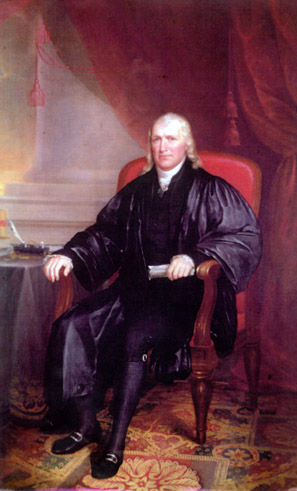
Samuel Chase was born in Somerset County, studied for the bar in Annapolis, and in 1765, was elected to the provincial legislature. Characterized as the "torch of the Revolution" in Maryland, Chase was an early protestor against parliamentary and proprietary interference. For leading the demonstrations of the "Sons of Liberty" against the Stamp Act, he was castigated as a "restless incendiary, a ringleader of mobs, a foulmouthed and inflaming son of discord."(1) In 1773 he joined the leaders of the anti-proprietary party in the Fee Bill debates, but, uncharacteristically, as attorney for Anthony Stewart, this "ringleader of mobs" attempted to prevent the burning of the tea ship Peggy Stewart.
In 1774 Chase was a member of the first Maryland Convention and Committee of Correspondence, served on the Countil of Safety in 1775, and in the Maryland Constitutional Convention in 1776. The most outspoken proponent of independence in the Maryland congressional delegation, of which he was an original member, Chase chafed under the restrictions of the Convention. Returning to Maryland in June, 1776, after a fruitless mission to win Canadian support for the colonies, he agitated for a change in the instructions. Reporting to John Adams on the situation in Maryland, he wrote, "I have not been idle. I have appealed in Writing to the People." When the restrictions were finally lifted on June 28, he wrote again: "See the glorious effect of County Instructions--our people have fire if not smothered."
When the Congress voted for independence on July 2 and 4, Chase was in Annapolis. "I envy you!", he wrote to Adams, "How shall I transmit to posterity that I gave my assent?" Reappointed to Congress on July 4, Chase was in Philadelphia on August 2 when the engrossed copy of the Declaration of Independence was signed and joined William Paca, Thomas Stone, and Charles Carroll of Carrollton in proving to posterity Maryland's commitment to American liberty.
Invariably described by friend and foe alike as a passionate and heated speaker, Samuel Chase continued to spark controversy throughout his long and active political life. He opposed the ratification of the Federal Constitution in 1788, and in 1804, as an Associate Justice of the Supreme Court, was impeached by the House of Representatives at the instigation of President Jefferson. Acquitted by the Senate, Chase resumed his place on the bench and remained on the court until his death in 1811.
Today this portrait is displayed in the Senate Chamber of the State House along with the portraits of William Paca, Thomas Stone and Charles Carroll, Marylandís other three Signers of the Declaration of Independence.